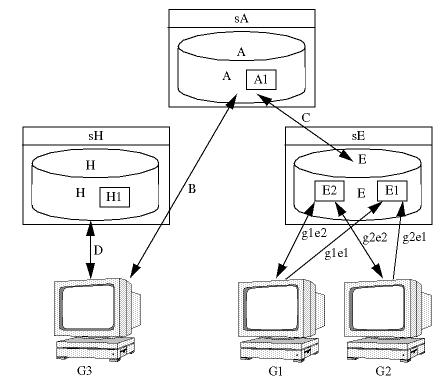How the Local Cache Works
The following graphic illustrates how the local cache works:
Following is the key for the graphic:
• A—Vault on master site.
• E—Local cache vault on cache server site.
• E1—A physical path on the file system corresponding to a folder to be used for mirroring in the local cache vault. Mirrored paths for folders cannot be used for downloads from the remote site.
• E2—A physical path on the file system corresponding to a folder that reads from and writes to the local cache vault.
• G1 and G2—Hosts whose users share the same site preference for downloads. The site preference is set to the remote site that also contains the local cache vault.
• G3—A host whose users have their download site preference set to a remote site that does not contain a cache vault.
• g1e1 and g2e1—Mounts to the mirroring folder in the local cache vault.
• g1e2 and g2e2—Mounts to the readable folder in the local cache vault.
• H—A vault that is not a local cache vault and is in another site. This vault is the preferred download site for the user of host G3.
• sA—Master site for sites sE and sH.
• sE—Remote site that includes a local cache vault and is the preferred download site for users of hosts G1 and G2.
• sH—Remote site that does not include a local cache vault and is the preferred download site for the user of host G3.
The time required for a user to check in, create, read, and update files is reduced, because these interactions involve data on the rapidly accessible cache vault rather than the more slowly accessible vaults on the master site. Unless these content files were requested earlier, they are replicated to the master site according to the sysForceSync synchronization schedule.
For example, when a user of host G1 checks in data, the checked-in copy is stored in local cache vault E rather than master site vault A, which would be the check-in vault if the local cache enhancements were not enabled. The data will be copied from vault E to vault A when an applicable sysForceSync synchronization schedule becomes active or when a request for the data arrives at site sA.
If users set their content cache preference to the remote site that holds the local cache vault, they can access data located there more quickly than users who only have access to that data on the master site. For example, if a user on host G2 wants to access content checked in by a user on host G1, the content is downloaded from local cache vault E, rather than the less rapidly accessible vault A on the master site. Not only is the access time reduced, but the data is also available earlier because of the faster check-in time on local cache vault E compared to master site sA.
If the master site receives a request for data that exists only in the local cache vault, the data moves immediately to the master site to enable it to serve the request. For example, if the user on host G3 requests content that exists in vault E and does not exist in vault A, the content is copied to vault A, and the content is then downloaded to host G3. The content is not transferred automatically to site sH unless a replication rule is created to transfer the content.
Because this is transparent to
Windchill users, there may be a need for clarification about whether data checked in to the local cache vault E has been copied to the master site sA. A utility that runs on the master sA site provides information about files that have not been copied to site sA yet. For more information, see
Utility to Assist Backups.
Maintaining two copies of data within the local cache vault protects it from loss or damage. Each local cache vault folder accessed by read and write operations can be associated with a folder that mirrors it when mount paths for both folders are specified in the same entry during configuration. If the folder that is accessed for read and write operations cannot be read, the contents of the mirror folder can be copied to the readable folder so that the read operation can continue. For example, the mount path g2e2 associates the readable folder E2 with the host G2, while the mount path g2e1 associates the mirroring folder E1 with the host G2. For more information about mirroring, see
Establishing Mirroring in the Local Cache Vault.
When content has been replicated from the local cache vault to the master site, it exists in both locations. If its structure in the local cache vault violates a rule, the violation is corrected when the rule becomes active.
Indexing is the collection of keywords from content to make it searchable. Data in the local cache is not indexed. Data is indexed when it moves from the local cache vault to the master site.
A download and upload JavaBean is available to implement the feature in applications. The Windchill Customization Guide describes this bean.

